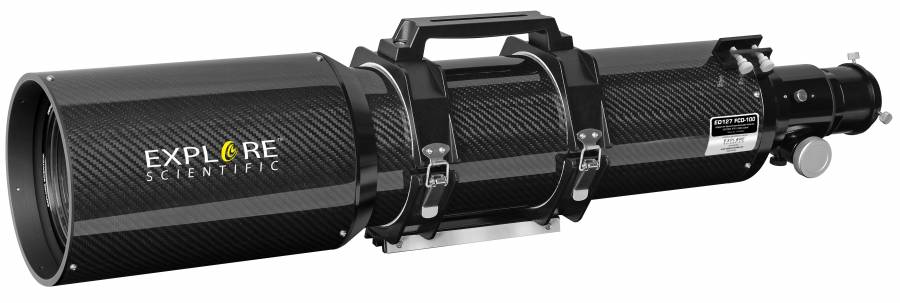Explore Scientific ED APO 127mm FCD-100 CF HEX Telescope
Apochromatic refractor. Objective lens diameter: 127mm. Focal length: 952mm
| Product ID | 71072 |
| Brand | Explore Scientific |
| Warranty | 2 |
| EAN | 4007922036328 |
| Package size (LxWxH) | 79x17x17 |
| Shipping Weight | 6.9 |
Highly corrected 127mm air-spaced triplet apochromat (with three lenses) and carbon fiber tube and a 2.5" high-precision Hexafoc focuser.
Apochromats are the ultimate choice in small to medium sized telescopes: the combination of compactness, transportability, very high image contrast and sharpness together with the possibility to make excellent astrophotos cannot be bested. The advances in glass manufacturing during the last few years have made true apochromats available to more astronomy enthusiasts than ever before. Explore Scientific FCD-100 CF Hex represents another major improvement in this field – the overall correction (color and spherical) is setting new standards in this price class. The optical design shows a polystrehl value of 0.97 indicating a level of correction that is absolutely top of the line.
This excellent apochromat is a very versatile telescope: the fast f-ratio makes short exposure times possible. The high contrast and sharpness of the image provide breathtaking views of large objects like the North America nebula or the Andromeda galaxy as well as tack sharp planetary images. The telescope is lightweight and compact – the dew shield slides down the tube to minimize size for transportation. Revolutionary glass and precision manufacturing created a telescope that offers observing joy on the highest level. This does not only qualify this telescope as the ideal travel scope, it is also the perfect choice for fast observations and for astrophotography. The excellent 2.5" Hexafoc focuser with 10:1 reduction is perfect for this – the large inner diameter of 65mm prevents vignetting by the focuser when the telescope is used for astrophotography with large sensors.
Features:
- Three lens apochromat with two air spaces
- Hoya FCD-100 glass for maximal color fidelity
- Weight: 5.2kg, lightweight due to carbon fiber tube
- High-end 2.5" Hexafoc 10:1 deluxe focuser
- 2" star diagonal 99% included
- Extension tubes for focuser (2pcs)
- Handle features mounting place for cameras
- 44mm universal dovetail with stainless steel protection included (fits Super/Great Polaris, EQ5, LXD75, EXOS-II)
- Dew-shield slides onto tube for easy transport
The kit includes:
- Optical tube with retractable dew-shield
- 2.5" Hex focuser with 1:10 gear reduction
- 2" star diagonal 99% reflectivity
- Tube rings with dovetail plate and handle
- Extension tubes for focuser (2pcs)
- Dust caps for front-lens and focuser
- Universal finder slot
| Product ID | 71072 |
| Brand | Explore Scientific |
| Warranty | 2 |
| EAN | 4007922036328 |
| Package size (LxWxH) | 79x17x17 |
| Shipping Weight | 6.9 |
| Optical design | refractor |
| Optical scheme | achromat |
| Optics material | ED |
| Optics coating | fully multi-coated |
| Objective lens diameter (aperture), mm | 127 |
| Focal length, mm | 952 |
| Lowest practical power, x | 38 |
| Highest practical power, x | 250 |
| Aperture ratio | f/7.5 |
| Resolution threshold, arcseconds | 1.1 |
| Eyepiece barrel diameter, in | 2 |
| Focuser | 2.5" Hexafoc, 2-speed (10:1) |
| Optical tube material | CFRP (carbon fiber-reinforced plastics) |
| User level | experienced users, professionals |
| Observed object | planets of the Solar System and deep-sky objects |
| Pouch/case/bag in set | case |
Convenient diagrams that describe how to install additional accessories on refractors and catadioptric telescopes
Find out how to assemble a telescope on an example of the Levenhuk Skyline 90x900 EQ telescope
This short guide will help you avoid typical mistakes and learn more about telescope and mounting types
The basics of astronomical observations for beginners
In this article we have gathered answers to some of the most frequently asked questions about telescopes
How telescopes work?
You can actually perform observations from your balcony!
All about telescope sizes, types, magnification, and mounts
Learn how to set up and use the telescope properly
Astronomy in light-polluted skies. Find out what you can observe in the city
Read an interesting comprehensive article on telescopes for little astronomers
Celestial objects you can observe with telescopes of different apertures
Colored and vivid images of galaxies, planets and star clusters entrance everyone who is fascinated by boundless space
Find an interesting review on the history of the changes to a refracting telescope
To make the process of choosing a telescope easier, we will tell you about the characteristics of the most popular types of telescopes today
Learn everything you need to know about refractor telescopes to make the right choice







